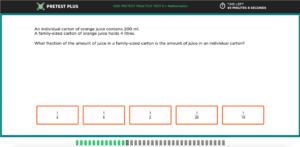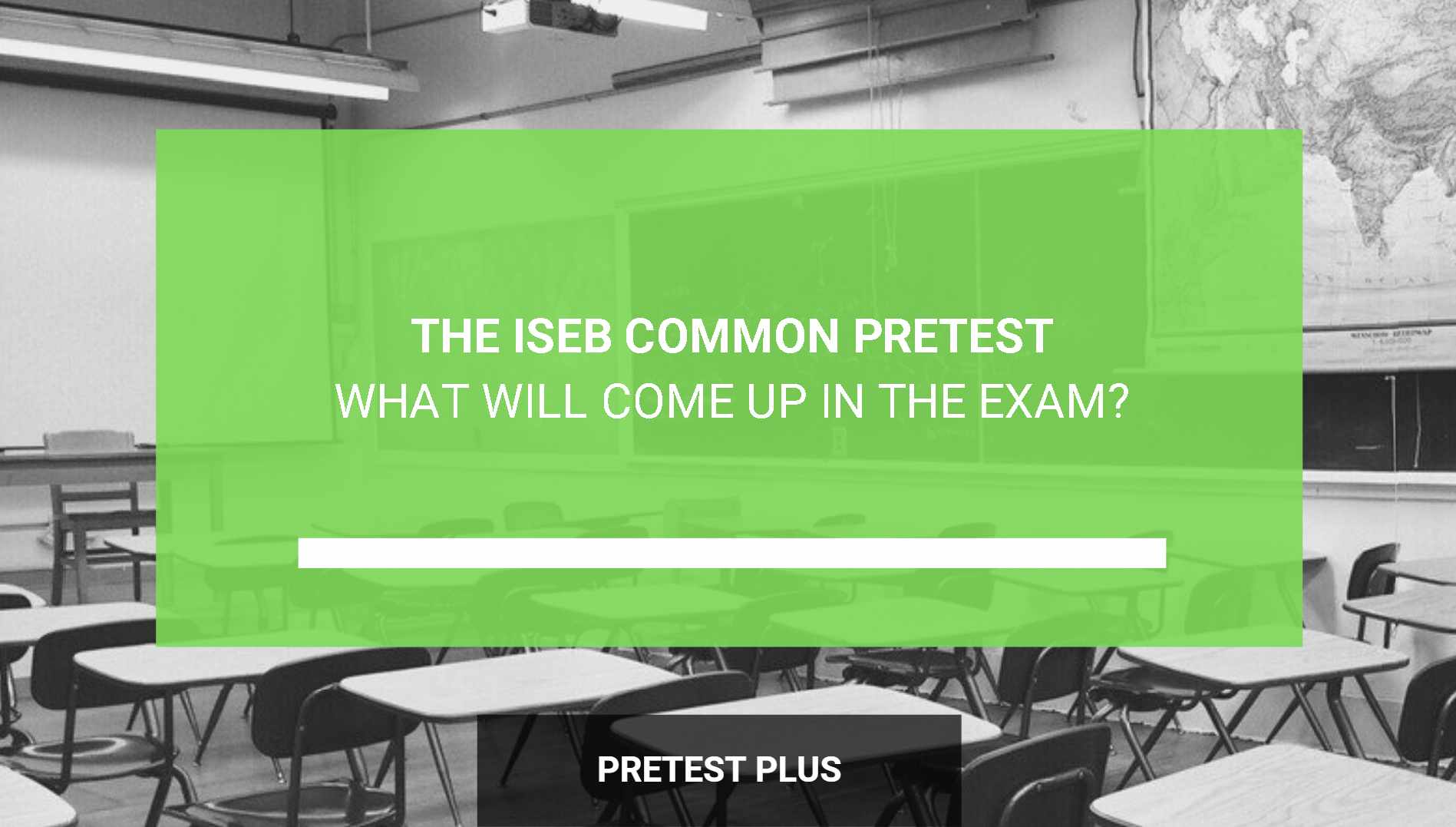
The ISEB Common Pretest: Which Types of Questions Come up in Each Section?
Bookmark this page? Pop your email into the box below to receive a link to this article so you can easily refer back to it later.
Table of Contents
NOTE: There have been some changes to this year’s ISEB Pretest. All of our ISEB Pretest Practice Tests have been fully updated to reflect these changes.
Click here to view a full list of the changes you need to be aware of.
Introduction
In this article, I’ll explain how the test works, what is covered, what your child does and does not need to know and which question types are most likely to come up.
The ISEB Pretest is a multiple-choice created by a company called GL Assessment.
The ISEB Pretest consists of four modules:
- Mathematics – 50 minutes
- English – 25 minutes
- Verbal Reasoning – 36 minutes
- Non-Verbal Reasoning – 32 minutes
The modules can be taken in any order. If your child is taking the test at their current school, they will probably split the test so they will take one or two modules per day.
It’s worth finding out whether your child will be taking the test in parts or all in one day as you can then practise in a similar manner.
Below, I’ve outlined what you need to know for each section:
English
There are three core question types that are tested:
- Comprehension
- Spelling & Punctuation
- Sentence Completion
These are the only question types that will come up.
The first 16 out of 32 questions will focus on Comprehension. There will be a passage on the left hand side of the screen that can be navigated by clicking on numbers just below it. We replicate this format exactly in our practice tests.
This screenshot from our ISEB Comprehension product shows you how this section will be laid out. You can see the passage is on the left and the question and answer choices are on the right. Each answer choice has an orange circle next to it. Your child must click on the circle next to the correct answer choice. The buttons 1, 2, 3 and 4 under the passage can be used to navigate through the different slides that make up the passage.
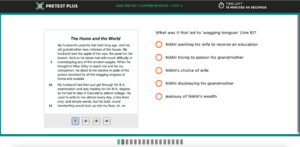
Comprehension questions in the ISEB Pretest will fall into one of these categories:
- Recall
- Word Meanings
- Types of Words and Phrases
- Inference & Deduction
- Language Techniques and Imagery
Each question is multiple-choice and contains five possible answer choices. One answer must be selected per question.
If you would like to specifically prepare for this section, I’d recommend using the tests in this product.
After the Comprehension questions, there will be 8 Spelling & Punctuation questions. These are all in the same format. Your child will need to read a sentence and then select the part of the sentence that contains an error.
The sentence is divided into four parts and the answer is chosen by hovering over the correct part and clicking.
If there is no mistake in the sentence, your child should select the option ‘No Mistake’ which is at the end of the sentence.
This screenshot from our set of ISEB Pretest Spelling & Punctuation Practice Tests shows you how the question is laid out. In this case, the part of the sentence with a mistake has been selected:
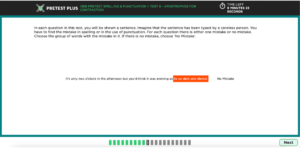
These types of questions are quite unusual but they feature heavily in many other GL Assessment tests. As such, they are quite predictable once you know which rules to look out for.
If you would like to see a full list of the Spelling & Punctuation rules that are tested, click here and then click on the green button labelled VIEW TEST PLAN.
Finally, there will be 8 Sentence Completion questions. These consist of a sentence with a word missing and five answer choices to choose from.
Here is a screenshot from our ISEB Pretest Sentence Completion Practice Tests that shows you how these questions will look:
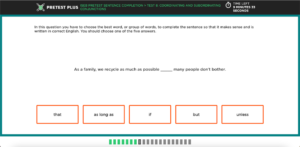
As with Spelling & Punctuation, these questions follow a specific pattern, with clear questions styles to look after.
Click here to view a detailed overview of these question styles.
In summary, you can see that the English section is quite formulaic and follows a very specific structure.
What’s not included
There are no sample or practice questions in the English section of the ISEB Pretest. There is an introductory screen before the beginning of each section and the timer is not paused for these. We have set up the English sections in our practice sections in the same way so your child can get used to the exact format.
Every day, we receive emails from parents asking if certain topics are included in the English section of the Pretest. The simplest response to this is if it’s not covered in our practice resources, it’s not covered in the Pretest.
This means your child does not need to know complicated and obscure grammatical terms such as adverbial phrases and demonstrative pronouns. Don’t waste your time learning this stuff because it doesn’t come up.
Furthermore, there are no questions which require your child to type in their answers. All the questions in the ISEB Pretest are multiple-choice with five answer choices.
The questions are also not in a random order. There will be 16 comprehension questions, followed by 8 Spelling & Punctuation questions all in the same format, followed by 8 Sentence Completion questions all in the same format. That’s it.
Our ISEB Pretest English Course covers all the topics mentioned above in a clear, step-by-step manner, explaining exactly how to approach each question type.
Mathematics
The Maths test is 50 minutes long and includes 36 questions. As such, it’s not extremely time pressured and so there’s no need to rush through it. Your child is allowed to use a pencil and paper to work things out as they go along. These workings are neither submitted nor marked.
It’s worth noting that there are four practice questions included before the official questions begin. However, the timer is running during these practice questions so it’s important not to spend too long on these. We have set up our practice tests to replicate this pattern so your child can get used to it.
It’s better that your child takes their time and focuses on accuracy. It’s important to get as many of the earlier, easier questions right as possible. Remember, you can’t go back and change an answer once you’ve moved on to the next question.
Officially, the test covers material up to the end of the Year 5 syllabus. However, that doesn’t mean the questions are going to be at an equivalent difficulty level. The test is taken by students in Years 6 and 7 and feedback we’ve received is that there are plenty of challenging questions included, even for brighter students.
In our ISEB Pretest Practice Tests, we’ve designed our Maths modules to replicate the flow and level of difficulty you can expect if you are to perform well.
We have divided the questions into three difficulty levels and progress through them, showing your child what they will need to tackle on the test if they are to do well.
In summary, the Maths section is perhaps the most straightforward in terms of format and there aren’t any great surprises. All the questions are multiple-choice and some of them will display diagrams/charts/tables for your child to interpret.
This screenshot from ISEB Pretest Practice Test 8 shows you how the questions and answer choices are laid out.
This screenshot from ISEB Pretest Practice Test 5 shows you an example of a question that includes a diagram:
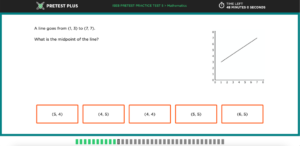
What’s not included
The main thing to be aware of when preparing for the Maths section is that you are practising at the right difficulty level. Certainly there are tricky and challenging questions in the Maths test. However, the questions do not require technical knowledge of concepts that are taught in secondary school. As such, just make sure the practice tools you are using are not pushing your child to answer harder and harder questions as they progress. This can unnecessarily affect your child’s confidence and give the impression that the actual test is much harder than it actually is.
If you’d like an overview of the complete ISEB Pretest Maths Syllabus, check out this video course.
If you’d like your child to practise targeted questions for each topic that could come up, click here to learn more about our ISEB Pretest Mathematics product.
Non-Verbal Reasoning
The Non-Verbal Reasoning section of the ISEB Pretest is 32 minutes long and contains 36 questions. As such, your child has around 53 seconds to complete each question on average.
Compared to other Non-Verbal Reasoning tests, this is a fairly generous time allocation, meaning your child has time to analyse each question carefully before selecting their answer. There’s no need to rush through the questions.
The ISEB Pretest is a GL Assessment test. That means it uses official GL Assessment Non-Verbal Reasoning question types. There are 11 of these in total. You can find a list of them here if you click the green button labelled VIEW TEST PLAN.
The test is designed to assess only 3 of these 11 question types. There will be 3 sections of 12 questions. Each section will include just 1 specific question type. An example and practice question will be shown before each section begins. The timer will be running while your child attempts these example and practice questions.
This is an example of a practice question from ISEB Pretest Practice Test 2. Practice questions are designed to be quite easy. They will show your child what the questions will look like and how they will need to respond. No marks are awarded for practice questions.
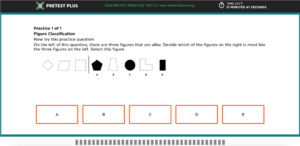
It’s important that your child understands the instructions before beginning the section as there are no instructions on the individual question screens. As you can see below, just the question diagram and the answer choice boxes are visible. This is an actual question from ISEB Pretest Practice Test 2.
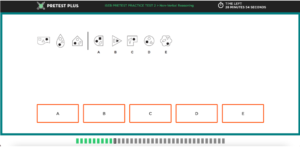
Within each section of 12 questions, the difficulty level will increase as your child answers correctly. We’ve set up our practice tests to show this progressive difficulty level.
It’s important to prepare for all 11 of the possible question types that could come up. We’ve created a question bank that covers all of them through three levels of difficulty. You can view it here. The questions in this product were created by an actual GL Assessment question writer so they are the most accurate you will find anywhere.
However, based on our research and the feedback we’ve received, we believe there are certain question types that are more likely to come up than others.
I have listed each of these below with an example. It’s extremely likely that at least one, if not more, of the below question types will come up in your child’s exam.
As such, it’s worth focusing on these question types if your child finds them difficult.
Horizontal Codes: the question below is from ISEB Pretest Practice Test 4
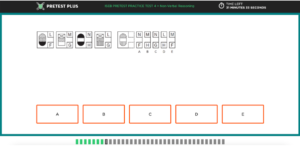
Classes Unlike: the question below is from ISEB Pretest Practice Test 10
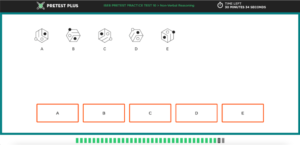
Classes Like: the question below is from ISEB Pretest Practice 6
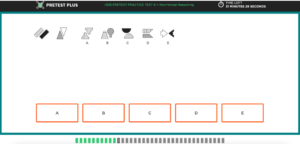
Analogies: the question below is from ISEB Pretest Practice Test 5
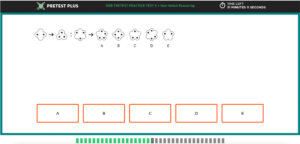
What’s not included
The main question we receive from parents is whether the test includes Spatial Reasoning questions, including blocks, cubes, nets and rotations.
The ISEB Pretest is changing this year and there will now be Spatial questions included. We will be releasing further information on this in a couple of weeks.
Verbal Reasoning
The Verbal Reasoning section of the ISEB Pretest is 36 minutes long and contains 36 questions.
The test had 4 subsections, each with 9 questions. Each subsection contains the same type of question, meaning only 4 different question types will appear in the test.
Each subsection is preceded by a sample and practice questions, just like in our practice tests. The timer is running during these practice questions so it’s important not to spend too long on them.
As you proceed through the questions, specific instructions for the question type will appear at the top of each screen.
There are potentially 16 GL Assessment Verbal Reasoning question types that could feature so your child will be tested on 4 of these. We cover all 16 possible question types across our ISEB Pretest Practice Tests.
The Verbal Reasoning section is the only one where your child will sometimes have to select two answers instead of one. It’s important that they read the instructions clearly but it’s also quite evident when two answers need to be selected as there will be 6 answer choices instead of 5 and the question will look like this example from ISEB Pretest Practice Test 7:
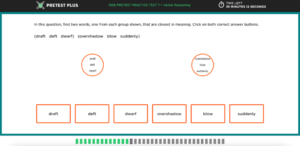
These are the question types that require two answer choices out of six to be selected:
Analogies
Compound Words
Synonyms
Word Opposites
And these are the question types that require one answer choice our of five to be selected:
Insert a Letter
Move a Letter
Word Pairs
Letter Analogies
Word Match
Letter Sequences
Embedded Words
Number Analogies
Word Relationships
Form a Word
Word Completion
Letter Codes
So which of these question types are most likely to come up? Based on our research and feedback we’ve received, these are the question types that appear most frequently:
Compound Words
Word Opposites
Letter Sequences
Form a Word
Move a Letter
Number Analogies
It’s extremely likely that at least 2 out of the 6 categories above will be included in the Verbal Reasoning section.
Click here to learn more about our ISEB Pretest Verbal Reasoning Skill Practice product. It covers all of the questions types listed above in question banks categorised by difficulty level and topic. It’s the most efficient way to improve and prepare for this section of the test.
What’s not included
It’s important to note that this section follows a specific structure with subsections. The questions are not in a random order.
One question we get asked a lot is if word puzzles are included in the Verbal Reasoning section. Our research indicates that they are not included. No student has ever mentioned them coming up before and there is no indication from ISEB that they are included.
The question types included in the Verbal Reasoning section will be from the list mentioned above. So make sure you are focusing on these if you want to prepare efficiently.
Summary
We’ve spent a lot of time researching and developing our new practice tests. Without a doubt, they are the most accurate ISEB Pretest Practice Tests you will find in the market today. Nothing else really comes close to showing you what these tests are actually like and which types of questions are actually included.
We encourage you to go through the official ISEB Pretest familiarisation demo here. If you’ve taken one of our practice tests before, you’ll notice how we have matched the format and style to ensure your child is making the best use of their time preparing for this test.
A few of the key benefits of our practice tests that you won’t find in any other practice material include:
1. Accurate module breakdown. Our modules are divided up correctly. That means 9 x 4 in Verbal Reasoning, 12 x 3 in Non-Verbal Reasoning and 16/8/8 in English. We don’t just include a random string of questions.
2. Accurate question types. We only include question types that can actually come up. That means no Spatial Reasoning in the Non-Verbal Reasoning section, no complicated grammar questions in English and no Word Puzzles in Verbal Reasoning.
3. Accurate level. Our tests show you the full range of difficulty levels you can expect in the test. That means no unnecessarily difficult and obscure questions just because you are doing well.
4. Tagged questions. Our questions are tagged by category and difficulty level so you can quickly work out your child’s strengths and weaknesses and know where to focus your efforts.
5. We include questions written by an actual GL Assessment question writer. We also include actual past questions.
6. Accurate design. Our tests are laid out and formatted exactly like the actual exam including small details like instruction wording, question template layouts, colours etc.
Full List of ISEB Pretest Practice Resources
ISEB Common Pretest Practice Tests
ISEB Common Pretest Video Courses
ISEB Pretest Non-Verbal Reasoning Course
ISEB Pretest Verbal Reasoning Course
ISEB Common Pretest Skill Products
ISEB Pretest English – Comprehension
ISEB Pretest English – Sentence Completion
ISEB Pretest English – Spelling & Punctuation
ISEB Pretest Non-Verbal Reasoning
Get 10% off orders over £80 and 20% off orders over £200. Use the code ppdiscount at checkout.
Bookmark this page? Pop your email into the box below to receive a link to this article so you can easily refer back to it later.

